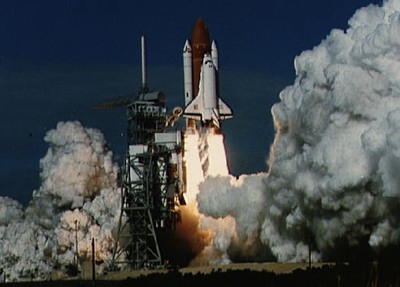Back in blackby Dwayne Day
|
| Certainly we won’t fully understand the shuttle’s legacy until some time has passed. Time is necessary because some parts of the shuttle’s history remain shrouded in secrecy. |
The broad outlines of many of these subjects are known, but the details are not. For instance, we know that cross-range requirements drove the orbiter’s designers to include a large wing, and we know that certain intelligence payload sizes drove the payload bay size. But as yet we do not have the details, including who, what, and when, for decisions made over forty years ago.
Gradually, however, some of the information on these first two points is being declassified. Certainly not a lot, not yet, and it will be many years—probably even decades—before we get a mostly complete account of those subjects. But some light is creeping in.
Take, for example, a recently declassified March 1981 document on “National Reconnaissance Program Utilization of the Shuttle.” The document, previously classified “Top Secret,” does not indicate who wrote it, but it was clearly intended to serve as an overview of where the National Reconnaissance Office’s various satellite programs stood just before the first flight of the shuttle. Columbia launched on April 12, 1981.
According to the document, the NRO had been transitioning reconnaissance satellites to the shuttle for several years while planning to maintain a backup expendable launch vehicle capability. But the shuttle program had slipped, the NRO had to change its own schedules, and evaluate its plan to phase out all expendable launch vehicles by 1985.
Attached to the document was the NRO’s utilization plan for the shuttle, which contains numerous deletions pertaining to the intelligence satellites then under construction that were planned to fly aboard the shuttle. The utilization plan for the first time provides a clear declaration of the NRO’s policy toward use of the shuttle before 1978: “The NRO will not commit any reconnaissance satellite program to final design and manufacturing which is dependent on a Space Shuttle capability until said capability has been demonstrated on orbit.”
According to the utilization plan, this meant that although the shuttle was planned to enter service in 1978–79, the NRO’s satellites would not start flying on the shuttle until 1984–85, “and even then, in many cases, would not be fully optimized to take advantage of the unique Shuttle capabilities.”
The NRO’s plan was not popular either with Congress or with the Carter Administration. As a result, the policy was revised in mid-1978, and some payloads—their identities are deleted—were then optimized to fly on the shuttle. At the time the shuttle was planned to be operational in August 1980, providing several years of margin before the satellites would fly. Other satellites, like the GAMBIT and HEXAGON reconnaissance satellites, which were declassified in late 2011, were scheduled for retirement rather than eventual launch on the shuttle.
| These documents are the first official confirmation of the NRO’s pre- and post-1978 policies towards using the shuttle. They are also the first confirmation that the first two scheduled NRO payloads had been specifically designed for shuttle launch. |
Unfortunately for the NRO, the shuttle’s operational date slipped by over two years, and Congress and the administration agreed to accelerate the launch of these payloads. The NRO was getting squeezed between a rock and a hard place and their schedule margin got a lot smaller. By the time of the first shuttle launch, all reconnaissance satellite programs would be dependent on the shuttle by the end of 1985, when the last expendable launch vehicles were phased out. This made NRO officials nervous, and the utilization plan acknowledged that, by this time, there had been a lot of discussion about whether it was wise to shift all of the NRO’s payloads to the shuttle or retain a backup expendable launch vehicle capability. Presumably, the transition to a new presidential administration and new leadership in the Department of Defense and elsewhere had also given shuttle opponents hope that the earlier decisions might be reversed. It is an old adage in Washington that if you don’t like a policy, you wait for a new administration.
The first classified payload launched on the shuttle was a satellite reportedly originally designated “MAGNUM” and renamed “ORION” by the time that it was launched aboard Discovery on the STS-51C mission in January 1985. ORION was reportedly a geosynchronous signals intelligence satellite. A second one was launched in 1989.
The shuttle utilization plan also stated, “Other uses of the Shuttle planned by the NRO includes checkout on orbit, development of satellite structures packaging to take full advantage of Shuttle payload bay volume, and use of astronaut extravehicular activity to assist in satellite deployment.”
The general outlines of this story have been known for a while now. The fact that the NRO leadership was reluctant during the 1970s to switch its payloads to the shuttle and had to be forced was revealed by former NRO Director Hans Mark in his 1987 book (see “The spooks and the turkey”, The Space Review, November 20, 2006.) But these documents are the first official confirmation of the NRO’s pre- and post-1978 policies towards using the shuttle. They are also the first confirmation that the first two scheduled NRO payloads had been specifically designed for shuttle launch.
We still have a long way to go to understanding these critical aspects of shuttle history, but perhaps we can finally take some of the first steps.
